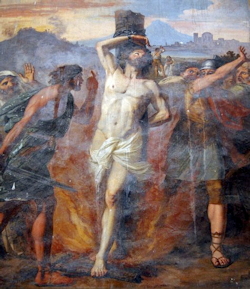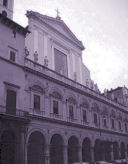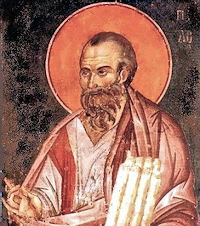Make your gift today!
Help keep Catholics around the world educated and informed.
Already donated? Log in to stop seeing these donation pop-ups.
Lent: February 23rd
Thursday After Ash Wednesday; Optional Memorial of St. Polycarp of Smyrna, Bishop and Martyr
» Enjoy our Liturgical Seasons series of e-books!
The ashes are scarcely washed clean from our foreheads. In this second Lenten Mass we get down to work on our spiritual program. The first four Masses in Lent are a unit. They describe the area of concentration and the dimensions of our Lenten program. Today’s Mass teaches that it is the soul’s life we are concerned with. The Opening Prayer at Mass is the usual one said when beginning a major work.
Today is the Optional Memorial of St. Polycarp of Smyrna (69-155), who was converted to Christianity by St. John the Evangelist. He was a disciple of the apostles and friend of St. Ignatius of Antioch. He was ordained bishop of Smyrna (now Izmir, Turkey) and was about eighty-six when the Roman pro-consul urged him to renounce Christ and save his life. St. Polycarp said, "For eighty-six years I have served Him and he has never wronged me. How can I renounce the King who has saved me?" He suffered martyrdom in 155 by burning at the stake in the amphitheater of Smyrna.
Meditation:
We disciples of the school of the Gospel have a new and overwhelming reason that calls us to ascetic duty. We are sinners, at least potentially; we must forestall or atone for our faults. We must expiate our shortcomings; we must punish the existing or renascent disorder in our being devastated by original and actual sin; we need some redeeming penalty.
Finally we have the obligation and the desire to follow in the footsteps of our Master, who said: “If any man would come after me, let him deny himself and take up his cross and follow me (Matt 16:24). The imitation of Christ: what a program!
Now we will merely reread to you a quotation from the ancient and great Origen; here it is: “Do you want me to show you again what fasting you must practice? Fast (that is, abstain) from all sin.” This is the fasting that pleases God.
—Pope St. Paul VI, April 4, 1973
Meditation on the Gospel, Luke 9:22-25:
Jesus is not content with demonstrating the eschatological necessity of his own suffering. He has prepared his followers too to accept, in the same spirit, a life of trial. In order to emphasize this teaching, Luke makes a somewhat artificial collection of Jesus’ sayings.
The verbs renounce, take up the cross, follow Christ are really synonymous. Each in its own way indicates what is the essential element of Christian life. In that he himself anticipates the punishment of the cross for his revolutionary ideas, Jesus is warning his followers that, if they remain loyal to his teaching, they must expect the same fate. Consequently one must reject all personal security and accept the mastery’s counsels (the rabbinic meaning of “following someone”) not only in theory but in practical life (“carrying the cross”).
In this context saving one’s life means abandoning Christ’s group of followers, deciding that it is dangerously revolutionary and looking for safety. Losing one’s life means risking life by remaining part of the group. The risk can only be undertaken in complete solidarity with the person of Jesus (“for my sake”).
If this solidarity is maintained throughout ones earthly life, it will be rewarded by an active share in Christ’s resurrection and his eschatological kingdom. It is thus that the paschal mystery is fulfilled for every Christian. This experience in death and resurrection becomes the lot of all his disciples. they in turn carry their cross so that they may live in glory with him.
—Guide for the Christian Assembly, Thierry Maertens and Jean Frisque
Highlights and Things to Do:
- Discuss the idea of forgiveness with your children — emphasizing with today's Gospel that Christ's forgiveness is limitless to those who humbly repent of their offenses against Him. Ask them ways in which they practice this virtue every day, with their sisters and brothers, with their parents, and with their friends.
- Throughout this fourth week of Lent, often the time when children begin to lose focus or weary of this penitential season, give them something tangible to work on, such as a Lenten Scrapbook, an ongoing activity that will engage their minds and stretch their creativity in putting their faith into pictures.
Saint Polycarp of Smyrna
 Polycarp had known those who had known Jesus, and was a disciple of St. John the Apostle, who had converted him around the year 80 AD. He taught, says his own pupil Irenaeus of Lyons, the things that he learned from the Apostles, which the Church hands down, which are true. Irenaeus, who as a young boy knew Polycarp, praised his gravity, holiness, and majesty of countenance. He had lived near Jerusalem and was proud of his early associations with the Apostles.
Polycarp had known those who had known Jesus, and was a disciple of St. John the Apostle, who had converted him around the year 80 AD. He taught, says his own pupil Irenaeus of Lyons, the things that he learned from the Apostles, which the Church hands down, which are true. Irenaeus, who as a young boy knew Polycarp, praised his gravity, holiness, and majesty of countenance. He had lived near Jerusalem and was proud of his early associations with the Apostles.
Polycarp became bishop of Smyrna and held the see for about 70 years. He was a staunch defender of orthodoxy and an energetic opponent of heresy, especially Marcionism and Valentinianism (the most influential of the Gnostic sects). Toward the end of his life he visited Pope St. Anicetus in Rome and, when they could not agree on a date for Easter, decided each would observe his own date. To testify his respect and ensure that the bonds of charity were unbroken, Anicetus invited Polycarp to celebrate the Eucharist in the papal chapel on this occasion. Polycarp suffered martyrdom with 12 others of his flock around the year 156.
—Excerpted from St. Polycarp, Bishop and Martyr by Fr. Paul Haffner (Inside the Vatican, February 2004)
Among the select few from apostolic times about whom we have some historical information is Polycarp, bishop of Smyrna and one of the most glorious martyrs of Christian antiquity. His life and death are attested by the authentic "Acts" of his martyrdom (no similar account is older), as well as by other contemporary writings. It moves us deeply when, for example, we find in St. Irenaeus, a disciple of Polycarp, the passage in which he reminisces:
"The memory of that time when as a youth I was with Polycarp in Asia Minor is as fresh in my mind as the present. Even now I could point to the place where he sat and taught, and describe his coming and going, his every action, his outward appearance, and his manner of discourse to the people. It seems as though I still heard him tell of his association with the apostle John and with others who saw the Lord, and as though he were still relating to me their words and what he heard from them about the Lord and His miracles. . . ."
On the day of his death (February 23) the Martyrology recounts with deep reverence:
"At Smyrna, the death of St. Polycarp. He was a disciple of the holy apostle John, who consecrated him bishop of that city; and there he acted as the primate of all Asia Minor. Later, under Marcus Antoninus and Lucius Aurelius Commodus, he was brought before the tribunal of the proconsul; and when all the people in the amphitheater cried out against him, he was handed over to be burned to death. But since the fire caused him no harm, he was put to death by the sword. Thus he gained the crown of martyrdom. With him, twelve other Christians, who came from Philadelphia, met death by martyrdom in the same city."
—Excerpted from The Church's Year of Grace, Pius Parsch.
Patronage: Against earache; against dysentery
Symbols and Representation: Wearing the pallium, holding a book representing his Epistle to the Philippians
Highlights and Things to Do:
- Listen to the Catholic Culture podcasts on St. Polycarp and his writings:
- Read more about St. Polycarp:
- Read an account of his martyrdom.
- Read St. Polycarp's Epistle to the Philippians.
- St. Polycarp's relics are located in the Sant'Ambrogio della Massima (St. Ambrose) in Rome, set in a marble memorial stone under the main altar.
 Friday of the First Week of Lent, Ember Friday
Friday of the First Week of Lent, Ember Friday
Station with Santi Dodici Apostoli (The Twelve Holy Apostles, also Santi Apostoli):
Today's station is at the minor basilica of the Twelve Apostles. Traditionally, this is the place where the Romans choose their candidates for priesthood (Rite of Election). It was erected by Julius I (337-352) over the barracks of ancient Rome's firemen and entrusted since 1463 to the Conventual Franciscans. Originally dedicated to the Apostles St. James and St. Philip, it was rededicated to all the Apostles in the 16th century.
For more on Santi Dodici Apostoli, see:
For further information on the Station Churches, see The Stational Church.






